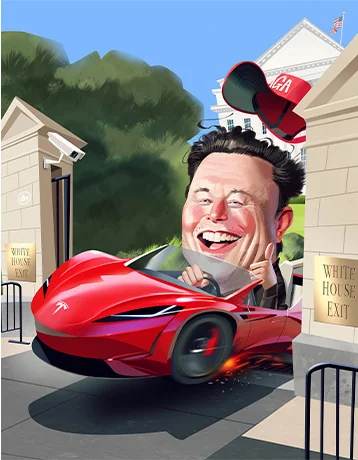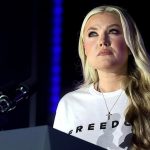When President Donald Trump convened his Cabinet for a meeting on the 100th day of his second term, his message was that he was just getting started. But for one of the high-profile figures in the room, it had the feeling of a swan song.
Elon Musk, point man for the Department of Government Efficiency, isn’t an official member of the Cabinet. Born abroad, he would not be in the line of presidential succession even if he was. DOGE isn’t a Cabinet-level department. Trump gave him a moment in the spotlight anyway, as he has done in previous Cabinet meetings.
“You have been treated unfairly, but the vast majority of people in this country really respect and appreciate you, and this whole room can say that very strongly,” Trump said of Musk in what sounded like a goodbye. “You’ve really been a tremendous help. You opened up a lot of eyes as to what can be done, and we just want to thank you very much.”
“And you know you’re invited to stay as long as you want, but at some point, he wants to get back home to his cars,” Trump added. At that point, the Cabinet burst into a round of applause. “They say I wear a lot of hats,” Musk quipped, with one Gulf of America cap stacked on top of another on his head. “Even my hat has a hat.”

When Musk entered Trump’s inner circle during last year’s presidential campaign, many thought the addition of a second strong-willed billionaire celebrity was putting a hat on a hat. It was widely predicted that This Town wouldn’t be big enough for the both of them, with Trump eventually resenting all the attention the tech titan received.
That doesn’t appear to have happened. If anything, Trump has at times appeared bothered that the political backlash prompted by their association has hurt Musk’s businesses. But even if they are not parting on bad terms, Musk is still leaving. His special government employee status is scheduled to expire at the end of the month. He reportedly told Tesla shareholders in a call late last month that he would scale back his DOGE work to one or two days a week until his contract ended.
It’s as good a time as any to review what Musk’s tenure has revealed about the challenge of curbing federal government spending. The federal budget is set to eclipse $7 trillion. The budget deficit has already reached $1.3 trillion for the first half of the fiscal year and is sure to exceed $2 trillion before it is over. This is when there is no recession (yet), the United States is not at war (directly), and the pandemic has been brought under control.
Nevertheless, the cancellation of a few Politico Pro subscriptions here and small (by Washington standards) contracts there elicited a response as if the libertarian economist Murray Rothbard had come back to life to unleash a new wave of anarcho-capitalism upon the land. The news coverage was unrelentingly hostile. Real, threatened, and imagined DOGE cuts brought about the first big protests of the second Trump administration.
DOGE was conceived as a task force to battle waste in the federal government, analogous to the Grace Commission, chaired by businessman J. Peter Grace (himself a wealthy longtime Democrat) under Ronald Reagan, or the National Partnership for Reinventing Government headed by then-Vice President Al Gore under Bill Clinton. With Musk at the helm, it became a lightning rod for critics and the great hope for small-government conservatives who feared the GOP had abandoned fiscal conservatism during the Trump era.
Part of this is because Musk dreamed big about making the government smaller. He initially said he believed he could cut $2 trillion, leaving it ambiguous whether this would be done through recommendations to Congress or more or less unilaterally. The actual figure will likely be far less grand. A pair of rescission packages proposed by the Office of Management and Budget, for example, is estimated to total some $9.3 billion in cuts. Lawmakers would need to vote on the proposals.
In three campaigns for the presidency, Trump has never run as a Barry Goldwater-style government-cutter. He eschewed the type of entitlement reforms championed by former House Speaker Paul Ryan, even in the Republican primaries. He was rewarded for this with the support of a more downscale electoral coalition than many previous GOP presidential nominees. Last year, Trump carried voters earning less than $50,000 a year and won an absolute majority of those making less than $100,000. Former Vice President Kamala Harris won those making more than $100,000 by the same margin, according to exit polls.
Trump did make more overtures to big- and small-l libertarians in 2024 than he did in his two previous campaigns. He even spoke at the Libertarian National Convention. The Libertarian Party’s presidential nominees won nearly 4.5 million votes in 2016 and more than 1.8 million in 2020. Trump was seeking to win the popular vote for the first time.
But even here, many of Trump’s campaign promises focused on acts of clemency (he pardoned Ross Ulbricht, a libertarian cause celebre, the day after he returned to office) and appointments. He also vowed to create DOGE and put Musk in charge of it but did little to lay the groundwork for what it was about to attempt. Musk said his mission was “ensuring that maniacally dedicated small-government revolutionaries join this administration.”
If Musk displayed the zeal of a convert, that’s because he was himself only a recent conscript in this small-government revolution. A talented if quirky entrepreneur and a fantastically successful businessman, he had been a centrist Democrat. It was not inevitable that he would support Trump at all, much less become one of the once and future president’s biggest financial backers.
Musk’s super PACs were not only flush with the tech baron’s cash. They, along with conservative activist Charlie Kirk’s organizational muscle, supplied much of Trump’s ground game in critical states. Musk and Kirk were arrayed against Harris’s experienced Democratic field operation in what was viewed as a lopsided contest. (Trump swept all seven battleground states.)
The SpaceX and Tesla founder also bought the social media platform Twitter and rebranded it as X. This led to Trump’s return from social media exile and helped many low-propensity voters find a way around traditional media sources that were hostile to Trump. Though he did not mention Musk by name, former President Joe Biden warned in his farewell address that a “tech-industrial complex” was taking shape “that could pose real dangers for our country,” rivaling the military-industrial complex President Dwight D. Eisenhower lamented as he left office.
“Americans are being buried under an avalanche of misinformation and disinformation, enabling the abuse of power,” Biden said. “The free press is crumbling. Editors are disappearing. Social media is giving up on fact-checking. The truth is smothered by lies told for power and for profit.”
Much of Musk’s interest in acquiring X stemmed from the Biden administration’s efforts to police such platforms under the guise of fighting disinformation. Biden was unbowed, saying, “We must hold the social platforms accountable to protect our children, our families, and our very democracy from the abuse of power.”
But Musk wasn’t exactly a nationalist-populist in the mold of Trump or Vice President JD Vance. He was sending out videos of free-market economist Milton Friedman extolling the virtues of capitalism and limited government. To some Trump supporters, that’s what they thought the MAGA-fied Republican Party was getting away from. Populists such as Steve Bannon viewed Musk with suspicion, both for his emerging techno-libertarianism and his extensive business ties to China.
Musk nevertheless landed his coveted assignment. In an announcement as president-elect, Trump said DOGE “will pave the way for my Administration to dismantle Government Bureaucracy, slash excess regulations, cut wasteful expenditures, and restructure Federal Agencies.” Musk was quoted as saying, “This will send shock waves through the system, and anyone involved in Government waste, which is a lot of people!”
Shock waves might have been an understatement. While it could not really touch entitlements, the biggest part of the fiscal crisis, DOGE demonstrated that nonprofit groups and other beneficiaries of federal largesse felt entitled to tax dollars. Some federal judges agreed. The burden of proof was not on those making a claim to the taxpayers’ money but on anyone suggesting that it should be cut.
Musk’s attempts to reduce and restructure the federal workforce were consistent with Trump’s desire to have the elected president get control of the Washington bureaucracy, in sharp contrast with his first term. Although Musk sought to assure the public he wasn’t being “capricious,” to many, his efforts seemed scattershot (such as when he had emails sent to federal employees asking them to summarize their recent work under threat of termination, often contradicted by Trump’s own agency heads).
Federal workers also tend to be articulate and disproportionately well-educated political opponents. They have proximity to the news media and are quick to share their stories, which soon became the basis of countless headlines. In his business ventures, Musk often moved quickly and then went back to fix anything he decided he had broken. The bureaucracy is a slow-moving beast that is historically less responsive to that kind of creative destruction.
As arguably the richest man in the world, Musk was in some ways an ill-fitting messenger for a government-shrinking initiative, especially one that entailed layoffs. He had none of Trump’s blue-collar appeal. He was more easily portrayed as a Mitt Romney-style “vulture capitalist” without the Bainiac’s bedside manner.
A recent Washington Post-ABC News-Ipsos poll found that just 35% of people approve of Musk’s handling of DOGE, while 57% disapprove. Musk’s poll numbers have generally been lower than Trump’s. Musk’s prominent involvement in an important Wisconsin judicial race earlier this year failed to produce a conservative victory and may well have backfired.
When Trump and Musk’s political foes began to fight back, the latter’s business interests became an inviting target. Tesla dealerships and even the electric vehicles were beset by vandalism and worse. The Trump administration described the incidents as domestic terrorism. Tesla’s customer base skewed Democratic, which set it up for a fall in profits once Musk became so inextricably linked with Trump. Elected Democrats such as Gov. Tim Walz (D-MN), the party’s vice presidential nominee in the last election, celebrated drops in Tesla’s stock price — despite, in Walz’s case, governing a state in which the pension fund is invested in the company’s stocks.
“I should say also, we will make mistakes,” Musk said of DOGE’s work. “We won’t be perfect.” The public, and especially the Democrats and their media allies, were not so forgiving.
There have been far fewer palace intrigue stories in Trump’s second term, but when they have come out, Musk is often at the center of them. No true believer in the tariffs agenda, he called top Trump trade adviser Peter Navarro a “moron” on X, prompting a grinning White House press secretary Karoline Leavitt to say “boys will be boys” when asked about the exchange in a briefing.
Musk appeared to pooh-pooh a $500 billion artificial intelligence project touted by the White House, saying on X that the investors “don’t actually have the money.” But Trump was understanding. “He hates one of the people in the deal,” the president said of Musk. “People in the deal are very, very smart people. But, Elon, one of the people he happens to hate. I have certain hatreds of people, too.”
In March, Musk clashed at a Cabinet meeting with Secretary of State Marco Rubio over reforms at the State Department. The DOGE chief also got into a heated argument with Transportation Secretary Sean Duffy, who was dealing with the fallout from fatal airline crashes. Afterward, Trump publicly clarified that his Senate-confirmed Cabinet officials and agency heads would make final decisions about staffing levels, not Musk. He also said the administration would use a “scalpel, rather than the hatchet” to make cuts and be “very precise” in personnel choices.
The spat over whether Musk should be granted a secret Pentagon briefing — Axios quoted Trump as saying, “What the f*** is Elon doing there? Make sure he doesn’t go” — may have even played a role in Defense Secretary Pete Hegseth’s problems. In this context, one wonders whether Trump’s Cabinet was cheering for Musk’s service on April 30 or his impending departure.
The first dustup of its kind during the second Trump transition was an apparent rift with Musk’s original DOGE partner, entrepreneur and former presidential candidate Vivek Ramaswamy. Ramaswamy’s real sin appeared to be his off-message cultural commentary in defense of H-1B visas — native-born Americans seemingly watch too much Saved by the Bell to excel mathematically — and he was preparing to run for governor of Ohio in 2026. Either way, he was out by the beginning of this year.
Now, DOGE could have a more significant reshuffle as Musk himself steps back. The identity of the group’s administrator, officially Amy Gleason rather than Musk, has always been a D.C. pub trivia question. With a less prominent public face, could the whole project get lost in the shuffle of tariffs and general Trump world tumult?
Or perhaps Musk isn’t going far. Fellow entrepreneur and Trump adviser David Sacks has likened Musk’s role in DOGE to his initial strong focus on X upon taking over the company, which was scaled back to more strategic management after he had implemented many of his desired changes. That could certainly happen with Musk’s White House involvement as well.
What Musk’s brief tenure in Washington has made clear is how difficult it is to rein in the federal government, with programs and a workforce that have taken on a life of their own. This is especially true since Congress has largely abdicated its constitutional duty on spending, as it has done in so many other areas. This made the types of cuts DOGE could realistically pursue less carefully targeted than they might have otherwise been, even aside from Musk’s mercurial personality.
It also meant that DOGE could not command the full support of the few small-government and libertarian voices in the capital because it did not follow clear processes and procedures. Whether that is more indicative of DOGE’s shortcomings or those of Beltway libertarianism will be hotly debated for at least the remainder of Trump’s term.
But it is legitimate to ask whether Musk’s merry band of machete men elicited too strong a political backlash without altering the country’s untenable fiscal trajectory, perhaps scaring off future spending cutters at a time when some budgetary discipline is sorely needed.
Musk’s young staff was also depicted as a group of reckless tech bros with little knowledge of government. Perhaps they should have been paired with more experienced government hands, combining both inside and outside perspectives. Either way, the administration could have pushed back against this narrative sooner. When Musk and his assistants finally appeared together on Fox News with Bret Baier in late March, they didn’t seem so radical. But by then, the narrative had set in.
AFTER 100 DAYS, CAN TRUMP PULL OFF A SECOND GREAT POLITICAL COMEBACK?
Any attempt to cut government spending has to begin with waste, fraud, and abuse. Wasteful spending is the least legitimate. It also illustrates how broken many government processes are and Washington’s fundamental lack of respect for the taxpayer dollar. But amid a debt and entitlements crisis, serious reform has to go well beyond waste.
Let’s hope that this lesson, at least, is not wasted.
W. James Antle III is executive editor of the Washington Examiner magazine.























